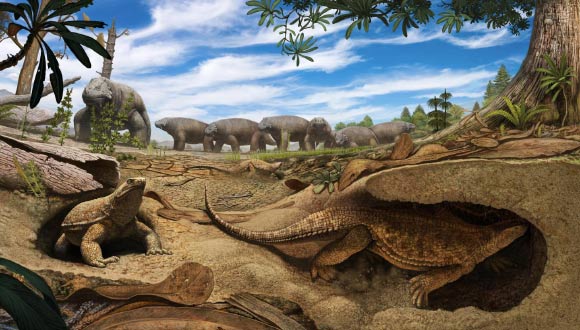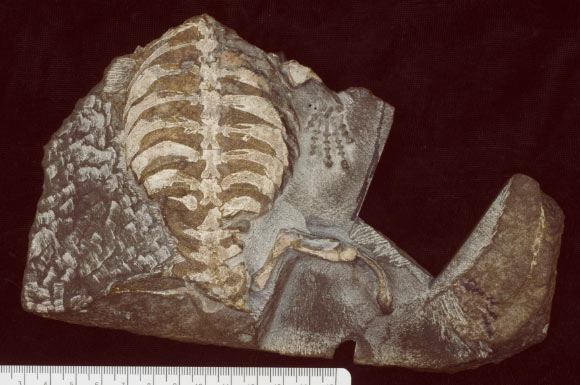A new study on the partially shelled fossil turtles suggests the broad-ribbed proto shell was initially an adaptation, not for protection, but rather for burrowing underground.

An artistic rendering shows an early proto turtle Eunotosaurus africanus (foreground) burrowing into the banks of a dried-up pond to escape the harsh arid environment present 260 million years ago in South Africa. In the background, a herd of Bradysaurus congregates around the remaining muddy water. Image credit: Andrey Atuchin.
“Just like the bird feather did not initially evolve for flight — we now have early relatives of birds such as tyrannosaur dinosaurs with feathers that definitely were not flying — the earliest beginnings of the turtle shell was not for protection but rather for digging underground to escape the harsh South African environment where these early proto turtles lived,” said lead author Dr. Tyler Lyson, from the Denver Museum of Nature and Science.
The early evolution of the turtle shell had long puzzled paleontologists.
“We knew from both the fossil record and observing how the turtle shell develops in modern turtles that one of the first major changes towards a shell was the broadening of the ribs,” Dr. Lyson said.
While distinctly broadened ribs may not seem like a significant modification, it has a serious impact on both breathing and speed in quadrupedal animals.
Ribs are used to support the body during locomotion and play a crucial role in ventilating your lungs.
Distinctly broadened ribs stiffen the torso, which shortens an animal’s stride length and slows it down and interferes with breathing.
“The integral role of ribs in both locomotion and breathing is likely why we don’t see much variation in the shape of ribs,” Dr. Lyson said.
“Ribs are generally pretty boring bones. The ribs of whales, snakes, dinosaurs, humans, and pretty much all other animals look the same.”
“Turtles are the one exception, where they are highly modified to form the majority of the shell,” he added.

A new fossil of the earliest-known turtle, Eunotosaurus africanus, discovered by then 8-year-old Kobus Snyman on his father’s farm in the Karoo in South Africa, suggests the turtle shell initially evolved not for protection, but rather as an adaptation for burrowing. The broadened ribs and the beginnings of the turtle shell provided Eunotosaurus africanus with a stable base from which it could use its large hands and spatula-shaped claws to burrow into the ground to escape the harsh arid environment found in South Africa 260 million years ago. Image credit: Tyler R. Lyson.
A breakthrough came with the discovery of several well-preserved specimens of Eunotosaurus africanus, the earliest-known (260 million year old) turtle.
“New fossil material of the oldest hypothesized stem turtle, Eunotosaurus africanus from the Karoo Basin of South Africa, indicates the initiation of rib broadening was an adaptive response to fossoriality (burrowing),” Dr. Lyson and co-authors explained.
“Similar to extant fossorial taxa, the broad ribs of Eunotosaurus africanus provide an intrinsically stable base on which to operate a powerful forelimb digging mechanism.”
“The adaptations related to fossoriality likely facilitated movement of proto turtles into aquatic environments early in the groups’ evolutionary history, and this ecology may have played an important role in proto turtles surviving the Permian/Triassic extinction event,” the scientists said.
Their findings were published online July 14 in the journal Current Biology.
_____
Tyler R. Lyson et al. Fossorial Origin of the Turtle Shell. Current Biology, published online July 14, 2016; doi: 10.1016/j.cub.2016.05.020







